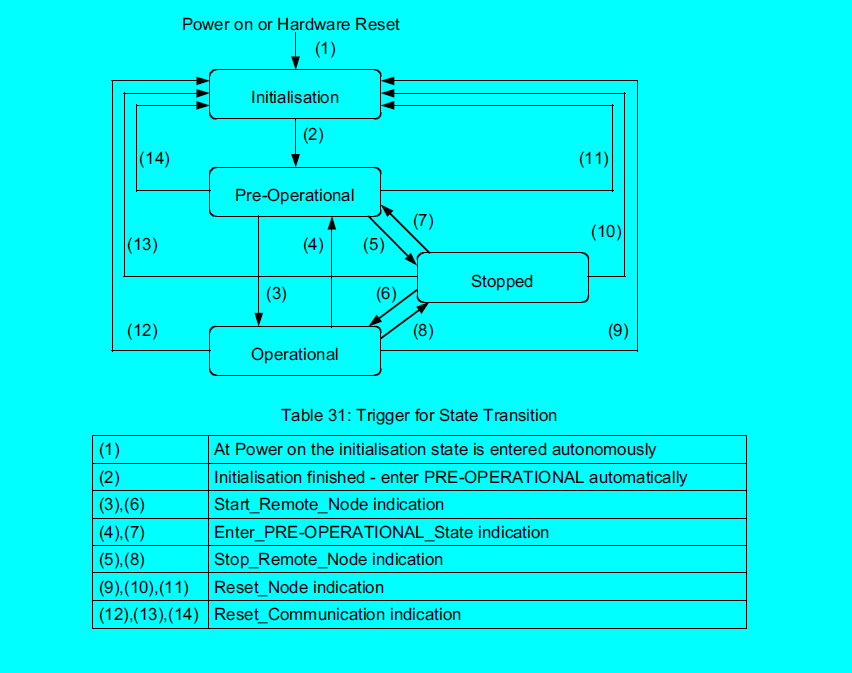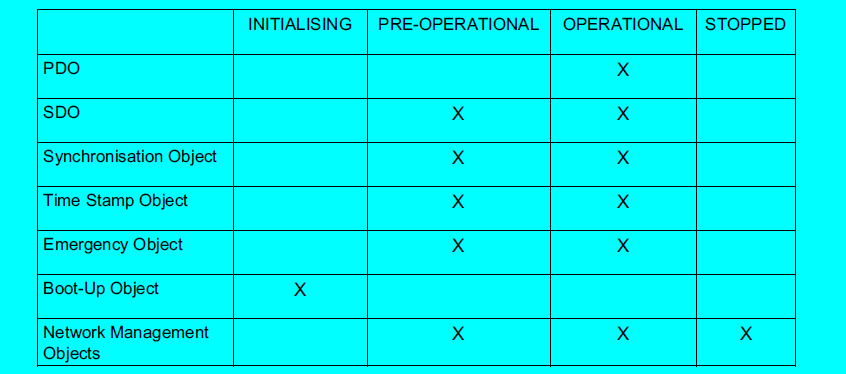Three types of communication relationships:
1. Master/Slave relationship
2. Client/Server relationship
3. Producer/Consumer
以上三种模式彼此独立,不同协议采用不同模式对应。并且C/S需要应答机制保证数据传输的可靠性。即After finishing the task the server answers the request The CANopen protocols comprise:
1. SDO protocol ——Service data objects
Enable access to all entries of a CANopen object dictionary
As these entries may contain data of arbitrary size and data type SDOs can be used to transfer multiple data sets (each containing an arbitrary large block of data) from a client to a server and vice versa
Direction of SDO:
a. write data to server using download
b. read data from server using upload
The indices of the corresponding Object
Dictionary entries are computed by the following formulas:
• SSDO communication parameter index = 1200h + SSDO-number -1
• CSDO communication parameter index = 1280h + CSDO-number -1
For
2. PDO protocol —— Process data objects
Used in CANopen for broadcasting high-priority control and status information. The transfer of PDOs is performed with no protocol overhead.
There are two kinds of use for PDOs:
a.Transmit-PDOs (TPDOs)
b.Receive-PDOs (RPDOs).
Devices supporting TPDOs are PDO producer and devices which are able to receive PDOs are called PDO consumer
Triggering events for PDOs are defined:

The indices of the corresponding Object Dictionary entries
are computed by the following formulas:
• RPDO communication parameter index = 1400h + RPDO-number -1
• TPDO communication parameter index = 1800h + TPDO-number -1
• RPDO mapping parameter index = 1600h + RPDO-number -1
• TPDO mapping parameter index = 1A00h + TPDO-number -1
3. NMT protocol
All CANopen devices must support the CANopen network management (NMT) slave state machine.

States and Communication Object Relation:

NMT protocol:

4. Special function protocols
a. Synchronisation (SNYC) protocol

b. Emergency protocol

c. Time-stamp protocol

5. Error control protocols
a. Heartbeat protocol
b. Boot-up protocol
c. Node-/Life guarding protocol
1. Master/Slave relationship
2. Client/Server relationship
3. Producer/Consumer
以上三种模式彼此独立,不同协议采用不同模式对应。并且C/S需要应答机制保证数据传输的可靠性。即After finishing the task the server answers the request The CANopen protocols comprise:
1. SDO protocol ——Service data objects
Enable access to all entries of a CANopen object dictionary
As these entries may contain data of arbitrary size and data type SDOs can be used to transfer multiple data sets (each containing an arbitrary large block of data) from a client to a server and vice versa
Direction of SDO:
a. write data to server using download
b. read data from server using upload
The indices of the corresponding Object
Dictionary entries are computed by the following formulas:
• SSDO communication parameter index = 1200h + SSDO-number -1
• CSDO communication parameter index = 1280h + CSDO-number -1
For
2. PDO protocol —— Process data objects
Used in CANopen for broadcasting high-priority control and status information. The transfer of PDOs is performed with no protocol overhead.
There are two kinds of use for PDOs:
a.Transmit-PDOs (TPDOs)
b.Receive-PDOs (RPDOs).
Devices supporting TPDOs are PDO producer and devices which are able to receive PDOs are called PDO consumer
Triggering events for PDOs are defined:

The indices of the corresponding Object Dictionary entries
are computed by the following formulas:
• RPDO communication parameter index = 1400h + RPDO-number -1
• TPDO communication parameter index = 1800h + TPDO-number -1
• RPDO mapping parameter index = 1600h + RPDO-number -1
• TPDO mapping parameter index = 1A00h + TPDO-number -1
3. NMT protocol
All CANopen devices must support the CANopen network management (NMT) slave state machine.

States and Communication Object Relation:

NMT protocol:

4. Special function protocols
a. Synchronisation (SNYC) protocol

b. Emergency protocol

c. Time-stamp protocol

5. Error control protocols
a. Heartbeat protocol
b. Boot-up protocol
c. Node-/Life guarding protocol